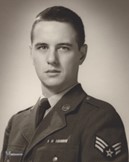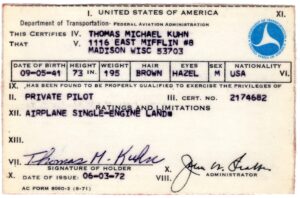Member's Bio
Tom Kuhn’s membership number in 006. Tom is the presiding President during PAM’s 40th anniversary (2024).
Tom is originally from Milwaukee Wisconsin and served in the United States Air Force for 3 years and 11 months mostly in Air Force Communications.
A job transfer brought Tom to Bloomington where he became involved with a new start-up museum.
Tom has been involved in many activities and positions as you will read in his My Story.
My Story
What you are about to read is an account of a young boy who liked to look up at airplanes that evolved into an affection for aviation.
My Love of Planes Changed My Life
As a youth, I was a typical boy growing up in Milwaukee, Wisconsin, always looking up when an airplane flew overhead, but other than that I had no real interest in aviation. That changed when I graduated from high school in 1959. I had no idea of what I wanted to do with my life. The answer came one evening when I went to a party and met an airman home on leave from the USAF – United States Air Force. I believe the next day I visited a USAF recruiter and a couple weeks later I was accepted. Shortly thereafter I was given a physical after which I was sworn in. I was now enlisted in the USAF for 4 years. I left that night for Lackland AFB in Texas for Basic Training. That was March 15, 1960. It was -15 degrees the night I left.
Early Duty Stations and Training
Lackland AFB was and still is a Basic Training base with no active runways. The only aircraft I saw while I was there were those flying overhead. I was at Lackland for 6 weeks when I was sent to Kessler AFB in Biloxi, Mississippi to complete my Basic Training and begin 36 weeks of schooling in electronics. The course was Radio Relay Repairman (Carrier & AN/TRC equipment). Kessler was an active base with several different aircraft: Lockheed T-33s, Convair T-131s and Grumman HU-16 Albatrosses. The HU-16s were flown by a Coast Guard Detachment that was stationed on the base. It did not take me long to get attached to the HU-16 and as it turned out, it became my all-time favorite aircraft. It was not a pretty airplane. When it took off it “waddled” down the runway. It was also not the fastest. I was once told by a former radio operator on a HU-16 “it was a 90 knots takeoff, 90 knots cruise and 90 knots landing airplane.” The HU-16 was also very noisy on takeoffs and early morning departures were not appreciated as my barracks was not that far from the runways.
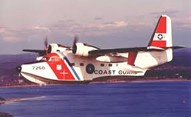
While at Kessler I had my 2nd ride in an airplane. It was in a Beechcraft B-18 Twin Beech. A classmate of mine whose father was a corporate pilot was flying down to visit his son and take him on a Saturday trip to New Orleans. He was told he could invite several of his friends to come along and he asked if I wanted to go. Of course, I said yes. We had to get a day pass, but that was not a problem. We had a good time seeing New Orleans and two establishments that remains in my memory were a bar called Pat O’Brien’s and The Court of the Two Sisters restaurant, both of which exist today. Fifty four years later my wife and I vacationed in New Orleans and we ate in The Court of the Two Sisters. The restaurant had not really changed and the ambiance was still there.

Off to See the World
On December 28, 1960, I had a very lonely Christmas, I left Kessler for a 30 day leave at home. Then it was off to my next duty assignment in Taipei, Taiwan. It turned out to be an arduous journey. I flew from Milwaukee to San Francisco on January 26, 1961. Then it was a bus to Travis AFB for my flight to Taiwan. Arriving at Travis, I was told my flight was scheduled for January 28th. That meant a 2 night stay in the Base’s Transit Barracks, with nothing to do but wait. Transit Barracks, by the way, are well known for their lack of hospitality. We departed as scheduled and I arrived in Taipei on February 1, 1961. Here is a breakdown of the journey. Our aircraft was a commercial DC-6 contracted to MATS (Military Air Transport Service) from Travis to Clark AFB in the Philippine Islands. The 1st leg of the journey was from Travis to Hickham AFB on Honolulu and a 3 hour layover. The 2nd leg was from Hickham to Wake Island, a lonely little U shaped island in the middle of the Pacific Ocean and another 3 hour layover. The 3rd leg was from Wake Island to Anderson AFB on the island of Guam, and yes, another 3 hour layover. The 4th leg was from Anderson to Clark AFB. Clark was a scene of some historic battles with the Japanese in WW II. Upon arriving at Clark, I was told my flight to Taiwan would leave the next day. So, it was another night in the Transit Barracks, which was okay as I really needed a shower. The 5th leg was from Clark to Taipei, Taiwan – I made it and I was very tired! The trip only took a total of 7 days! On Taiwan, I was assigned to the 1265th AACS Squadron (MATS) which was located in a small base called Taipei Air Station.
Taipei, Taiwan
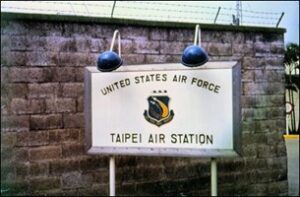
Taipei Air Station was in the center of Taipei next to the Taiwan University and therefore had no airplanes. A tour of duty on Taiwan was 15 months. A brief note – Taipei in 1961 was rather a primitive place. The poverty really caught me off guard because I was never told what to expect. Also, the island was a Nationalist Chinese military fortress that was less than 100 miles from Communist China mainland. Two months after arriving I was put a special project on a Nationalist Chinese Air Base called Taoyuan. I worked 24 hour shifts on site with 48 hours off in Taipei. There was a lot of aircraft on Taoyuan, but the one I remember the most I cannot talk about. The next one was the North American F-86 Saber Jet. The Nationalist Chinese pilots were interesting to watch as they were rather reckless.
Nationalist Chinese F-86 Saber Jet
In June 1961, I was sent to Clark AFB for 8 weeks to cross train into on-line encryption systems. At that time, Clark was a major US military installation in Southeast Asia and therefore had a lot of different types of aircraft on its flight line. Clark was a huge base and the flight line was several miles away from my barracks and classroom. It was not like Taoyuan where I could watch aircraft all day long. When I got back to Taipei, I spent the rest of my time learning and working in my new job classification. As I mentioned above, a tour of duty on Taiwan was 15 months so on April 22, 1962, I signed out of my squadron, was driven to the Taipei airport for a morning MATS flight to Clark. I arrived at Clark around noon and by 6:00pm I was on a Pan Am flight heading for Anderson AFB on Guam. There was a brief stop for more passengers and fuel. Then the next stop was Hickham AFB on Honolulu where I had my first glass of fresh milk in 15 months. After about 3 hours, we were back in the air heading for Travis AFB. Brief note – the Pan Am flight was on a new Boeing 707 airliner. The flight was “very” nice. The seats were comfortable and the food excellent! And the 1962 the flight from Clark to Travis was almost half the flight time from Travis to Clark in 1961. It was a flight I will always remember!
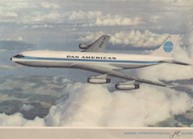
The USA And Then Barksdale AFB
After another 30 day leave at home, it was good to be back home after Taipei’s poverty, I headed for my new duty assignment at Barksdale AFB in Shreveport, Louisiana. I arrived on May 1, 1962. I was assigned to the 46th Communications Squadron, 2nd Air Force, SAC (Strategic Air Command). Barksdale was the Headquarters for the 2nd Air Force.
Strategic Air Command
Barksdale was a SAC base that had Boeing B-52 Stratofortress bombers, Boeing KC-135 Stratotankers and various other support aircraft. There was also a Reconnaissance Squadron on base that flew Lockheed U-2s. They were not part of SAC. They made numerous flights during the Cuban missile crisis. Watching a B-52 taking off was interesting as its nose down attitude on takeoff was the only aircraft that I knew of that took off in that manner. So, now I had all the airplanes I ever wanted to watch – when I had the time.
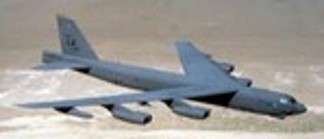
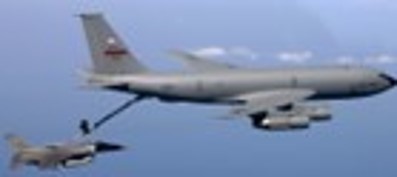
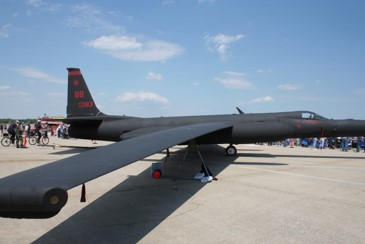
My job at Barksdale was quite different from my last duty station. At the Taipei Air Station, I worked in just one communications center. At Barksdale I operated and maintained on-line encryption systems at several different locations on and off the base. The locations ranged from the Base communications center, a Major General’s office, an OSI office (Office Scientific Intelligence), a SAC KC-135 flying command post called Looking Glass and Bossier Base, a nuclear weapons depot. I had some “very interesting” experiences in each location with Looking Glass the most memorable. But then, Bossier Base was something I will never forget.
On October 1, 1962, I was promoted to Airman First Class (A1C) an E-4 ranking. I was now going to be paid $160 a month.
Cuban Missile Crisis:
In the end of October 1962, I took a brief leave to go home for my sister’s wedding and to pick up my first car. It was a 1957 four door Chevrolet sedan. At that time, the Cuban Crisis was going on. On October 24th, I received a telegram saying that Barksdale AFB was on “alert status” and my leave was cancelled and that I was return to base ASAP. It took 2 days to get back to Shreveport. When I arrived, Barksdale was on lockdown and the whole base was very tense. The crisis was hard on all personnel. Enlisted men who were not married were confined to base. We worked 12 hours shifts with no days off. On the 29th, the crisis ended and we reverted to our regular work schedules. As I reflect of that time, I am grateful that the situation did not end up in a nuclear war. Barksdale was a major SAC base and it would have most certainly been targeted in a first nuclear strike and I would not be writing this narrative today.
Temporary Duty at Grand Forks AFB
On July 24, 1963, I was sent to Grand Forks AFB in North Dakota on TDY (Temporary Duty) for 60 days to provide technical assistance with their on-line encryption systems. The reason I was sent was that Grand Forks was a TAC (Tactical Air Command) base and it was being taken over by SAC. I took a military flight from Barksdale to Offutt AFB in Omaha, Nebraska. When I arrived at Offutt, I was told my flight to Grand Fork would be delayed. When I went to check out my next airplane, I found a Douglas C-47 Skytrain (aka Gooney Bird) with a flat main tire. Well, that took about 4 hours to change and then we, just a full bird Colonel and me, were off to Grand Forks. At that time the McDonnell F-101 Voodoos were stationed at Grand Forks. The F-101 was a long-range fighter interceptor. Another version, the RF-101, was a photo reconnaissance aircraft. Both were advanced for their times. So, here I was with another opportunity watch different airplanes but only again if I had the time.
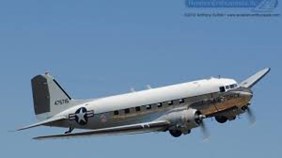
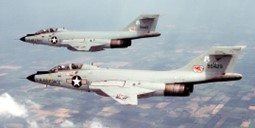
When I arrived, they did not have a place on base for me to stay. So, I was put up at the Ryan Hotel in downtown Grand Forks. The Ryan Hotel had the best restaurant in Grand Forks. In the mornings at 7:30, I and several officers were picked up and driven to the base. At 4:30 in the afternoon we were driven back to the hotel. Then I was free to do whatever I wanted until the next morning. Talk about good duty! My job of assisting in the changeover went well. However, after 7 weeks I was told I had to stay on base and in the Transit Barracks. That was not good news and life in the Transit Barracks did not come close to staying at the Ryan. Then on September 5th, my birthday, it snowed! Checking with some locals I was told winter was not far off. So, I made a phone call to Barksdale telling them I was no longer needed and to make travel arrangements for me back to Barksdale.
On September 13, 1963, I was on a flight to Barksdale. On the way we made several stops at AFBs and one was Bunker Hill AFB in Indiana. While taxing to the base terminal, I saw one of the most incredible aircraft ever built– a Convair B-58 Hustler. The B-58 was advanced beyond anything that flew. It was the first operational bomber capable of Mach 2 flight, twice the speed of sound. The B-58 set 19 speed records, including the longest supersonic flight in history. In 1963, it flew from Tokyo to London (via Alaska), a distance of 8,028 miles with 5 aerial refuelings in 8 hours, 35 minutes, 20.4 seconds, averaging 938 mph.
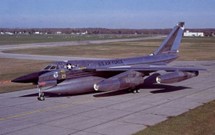
Back to School
Back at Barksdale AFB, I settled in being an airman doing my job and trying to make the most of my free time. In mid November 1963, I was told that I was eligible for another on-line encryption system school at Lackland AFB in Texas. However, to go I had to extend my enlistment 2 months. I thought it over and said why not, it was only another 60 days. So, instead of being discharged on March 14, 1964, my new date was May 14, 1964. On December 16, 1963, I left for Lackland driving my own car.
I am not too sure how to explain the next 3 months, but here it goes. It was a very interesting time. When I left Lackland in April 1962, I was Airman Basic (AB) with “no” stripes on my sleeves. Now I was an Airman First Class (A1C/E-4) with 3 stripes. I was assigned to a barracks with 2 US Navy sailors, who were also E-4s, as my roommates. The sailors were in the same class as mine. The Air Force expected the sailors to follow Air Force rules and regulations which they did not! That led to some hubris situations. We were supposed to go to school from 6:00pm to midnight, which we did not. The whole class had backgrounds in on-line encryption systems so we usually finished our studies by 9:00pm. To solve that problem, a Senior Master Sargent in our class, made a deal with the school NCO, strictly confidential, which allowed us to leave by 9:00pm. By 10:00pm, we were in the Lackland NCO (Non Commissioned Officers) club. At Lackland, E-4s were allowed to join the NCO Club which led to some rather enjoyable times.

The End
School ended on March 26th so it was back to Barksdale AFB. My remaining time in the USAF was again being an airman doing my job and trying to make the most of my free time. It was right after I got back from Lackland that I was told that I was going to receive a 3 month early discharge. That was okay with me because I was ready to go. My 3 years and 11 months in Air Force were good. I had no complaints. I traveled in the Far East and I experienced places and worked jobs that most people never knew even existed. However, I had no desire to make a career of the Air Force. So, on February 14, 1964, I packed my belongings into my car, went to the Squadron Orderly Room to sign out for the last time. As I drove out of the back gate of Barksdale, I looked into the rear view mirror. As the gate became smaller and smaller the realization set in that I had to start all over again with a new life, one which I was not sure what I was going to do.
A1C Thomas M. Kuhn Fall 1963
Transitioning to Civilian Life
The next five years were spent reclaiming my “civilian” life. In the fall of 1964, after several attempts of finding worthwhile employment, I decided, after much urging by my best friends, to go to college. In the fall, I enrolled in a Junior college in Milwaukee. After being away from school for so long, it was decided that it would be best for me. So, there I was, 23 years old going to school with all those “kids” and feeling out of place. But I found a couple of Veteran’s and we all pulled through together. I did well that first year, so in the fall of 1965, I enrolled in the University of Wisconsin-Milwaukee (UW-M.) So, there I was again, now 24 years old now going to school and feeling out of place. That’s when I found the UW-M Veterans Club. A great bunch of guys! I credit my association with the Club for easing my time at UW-M and helping me to graduate.
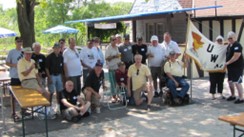
Before graduating, I did the usual job interviewing and prayed that one would work out for me. In January 1969, I graduated with a degree in Economics. And that was after almost 2 years of USAF schooling in electronic systems. However, that training would soon help me to find a job.
Now, it should be noted that during my college years, I had very little to do with airplanes other than looking up once a while and watched them fly by overhead and see if I could identify them.
Employment Found
In mid-January 1969, I was offered a job with the General Telephone Company of Wisconsin. The position was in their Traffic Department. The monthly salary far exceeded my last salary in the USAF. I accepted the position. Once again, I packed my belongings and I moved to Madison, Wisconsin. On February 3, 1969, I started new position as a Traffic Engineer. About 2 years later a new fellow moved into our Department and was assigned to the section that I worked in. As it turned out, he was a licensed private pilot. We soon became good friends. That is when I learned that another fellow in our Traffic Department was also a licensed private pilot. It took them a while to convince me that I should get my pilot license, but I finally gave in. So, I went out to Truax Field Madison, Wisconsin’s airport and took a $5 introductory flight. Upon landing I was hooked! I started my flight training at Four Lakes Aviation on Truax field. On February 19, 1972, I had my first flying lesson. The airplane was a Piper PA28-140 Cherokee N5819U.
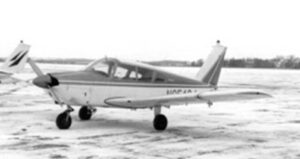
My first flight instructor was Lee Toby. Lee, besides being a Flight Instructor, also flew Convair F-102 Delta Daggers for the Wisconsin Air National Guard. He always amazed me with his stories of what it was like to fly a F-102.
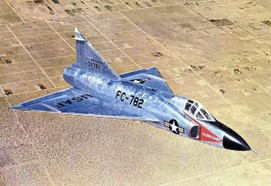
On March 28,1972, I soloed for the first time with 2 takeoffs and 2 landings. The first landing was almost perfect and the second was not even close. On April 29, 1972, I was checked out for solo cross country flights. On June 3, 1972, I passed my check ride and was issued my Private Pilot license with a Single Engine Land rating. During this time, I also attended Private Pilot ground school at the Madison Area Technical College.
I continued my flight training with the idea of obtaining a Commercial rating. I even took the written test for the rating and did quite well. During this training period I had my share of flying experiences. Some were enjoyable and some were not so enjoyable, but that is the way of aviation. Another way of expressing it is “hours and hours of boredom punctuated by seconds of sheer terror.”
On November 3, 1973, I married the girl that I grew up with and settled into married life. I continued my flight training, but in November 1974, I had my last flight. It was getting too expensive. What I spent on an afternoon of flying; I could take the family camping for a weekend. So, that was it.
I ended up logging 175 flight hours all in single engine land aircraft. I was back again in observing airplanes flying overhead. However, this time it was different. When I looked up it was with missed emotions of my time in the cockpit.
Transferred to Bloomington, Illinois
In February of 1981, my employer GTE transferred me to Bloomington, Illinois. I was not too excited about the move, but I had a family to look after and Bloomington did have an airport. It was of a size that had airplanes flying overhead now and then. So, here I was again looking up with missed feelings of my time in the cockpit. Then one Sunday morning I was reading the newspaper when I noticed an article about four local gentlemen who were in the process of creating an organization to locate, restore and fly a C-47 airplane. That perked my interest because the C-47 was another one of my favorite airplanes. In June 1982, I became a member of Heritage of Flight – Gooney Bird Chapter. In August 1984, the name of Heritage of Flight was changed to Prairie Aviation Museum better known as PAM. I was back again in aviation, not flying but doing the next best thing.
Prairie Aviation Museum and N763A
First a little history – during WW II, the Douglas Aircraft Corporation built for the USAAF (United States Army Air Force) two versions of its DC-3 airliner. One was the C-47 Skytrain which was strictly a cargo aircraft. The second was a C-53 Skytrooper which was a passenger airplane. The C-47 had 2 large cargo doors whereas the C-53 had a standard passenger door. During the war, no airliners were built. When WW II ended there was a surplus of C-47s and the C-53s which were sold to the airlines by the War Assets Administration. The airlines usually choose the C-53 as it was a passenger aircraft and therefore easier for the airlines to convert them into DC-3 airliners.
In February 1984, PAM purchased its first aircraft, an DC-3 airliner, tail number N763A from Tradewinds Aircraft Sales in San Antonio, Texas. It was built by Douglas in its Santa Monica, California plant as a C-53 aircraft. Its serial number was AC41-20124 with an acceptance date of March 11, 1942. After World War II ended it was sold by the War Assets Administration to Southern Airways. Shortly thereafter it was converted by Douglas into a DC-3 airliner and assigned tail number N763A. Southern flew N763A for a few years and then sold it to Eastern Airlines. It was eventually purchased by businessman H. H. Coffield of Rockdale, Texas and was used as a corporate aircraft flying everything from chickens to Hollywood movie stars.
I spent many an hour polishing and cleaning N763A and helping with required annual inspections, getting her ready to go to the next airshow. I also had the pleasure of taking 2 fights in the ole bird. Flights were made to airshows to display our DC-3 and sell rides. A couple was married in N763A while flying over the state of Iowa. For a brief period, the museum offered an DC-3 ground school where pilots came to acquire a DC-3 Type Rating. Some came as far as England. Eventually though, the cost of keeping her airworthy became too excessive and the museum had to part with our beloved DC-3. On April 23, 2009, after 25 years of loving care by a small group of faithful keepers of N763A, gathered to say goodbye and watched her leave for the last time.
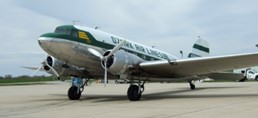
My Time AT PAM
Over the next 39 years, PAM acquired 12 addition aircraft. You can view each one by going to our website’s menu and clicking on Airpark. I was involved with each aircraft from raising funds to bring them to Bloomington to helping to organize the airpark to keeping them in presentable condition. Today, each aircraft brings back memories of how hard everyone worked to keep N763A in the air and to make the Airpark what it is today. But the most memorable for me will always be N763A. She was a special ole bird with a distinguished history in aviation.
During my association with PAM, I performed many activities volunteering from creating aviation displays, conducting visitor tours, cutting grass and shoveling snow. I was also involved in maintaining the museum’s membership and visitor attendance. Then there were the PAM airshows. In 1987, we started with having an annual one day mini event on a weekend, usually in late summer. It was called a Day At The Airport. They were very successful which eventually led to full blown two day events. In 1993 and 1994, I was Co-director of the airshow. Putting on an airshow was a lot of hard work and very time consuming. We always made sure that we had a crowd pleasing event that would make our guest want to return the following year. The airshows bring back a lot of good memories for me. They were run mostly by volunteers, sometimes as many as 150 people. Everyone worked long hot hours, but it was worth it because our airshows were always successful and that made all the difference.
Over the years, I have held several positions with PAM: Member, Board of Director, Vice President and today, President. I have made many good friends over the years, met some “very interesting” people and had the honor of representing the finest air museum in Central Illinois, the Prairie Aviation Museum.
So, this is my story and all the aircraft that became part of my life. Hopefully there will be a few more. I still look up whenever an airplane flies over head.
Tom Kuhn
